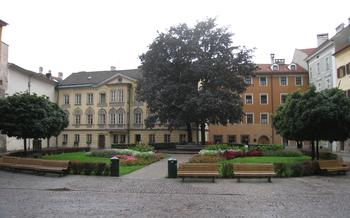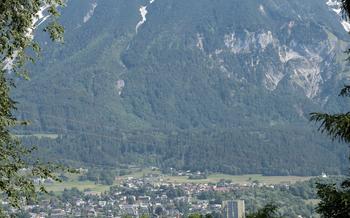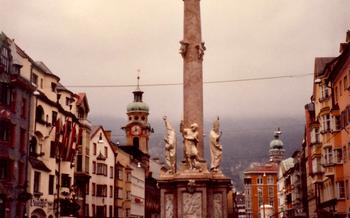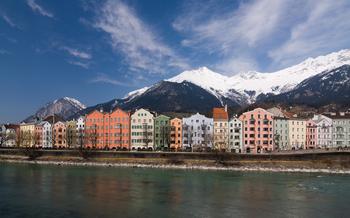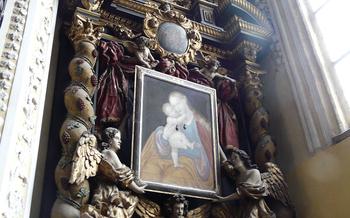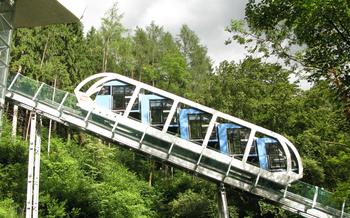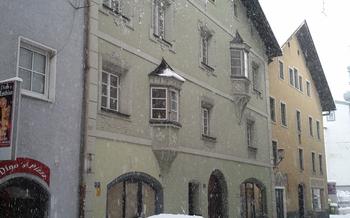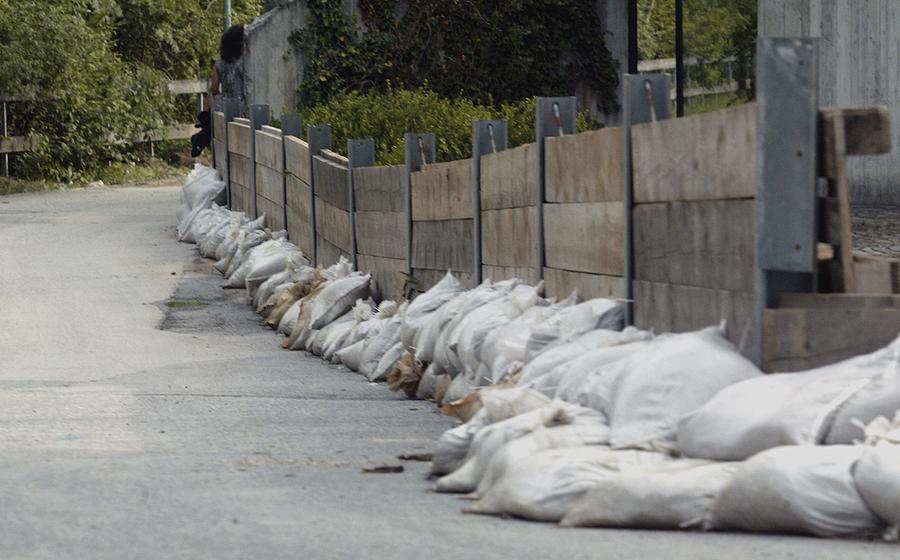
Hofkirche and the Emperor's Tomb
- Hofkirche and the Emperor's Tomb
- The Black Men: Unveiling the Mystery
- The Hofburg: A Legacy of Imperial Grandeur
- The Silver Chapel
- The Hofgarten: A Serene Oasis in the Heart of Innsbruck
- Exploring the Old Town
- The Golden Roof
- The City Tower: A Panoramic Ascent
- The Tyrolean State Museum: A Journey Through the Heart of Tyrol
- The Alpine Zoo: A Haven for Alpine Wildlife
- The Nordkette Mountains: A Breathtaking Alpine Adventure
- Insider Tip: Uncovering the Secret Passageway
Hofkirche and the Emperor's Tomb
In the heart of Innsbruck, Austria, stands the Hofkirche, an awe-inspiring Gothic masterpiece that houses the elaborate tomb of Emperor Maximilian I, the last Holy Roman Emperor. Constructed between 1553 and 1563, the Hofkirche is a testament to the power and prestige of the Habsburg dynasty that ruled over Austria for centuries.
With its soaring arches, intricate carvings, and stained-glass windows, the Hofkirche is a visual feast that transports visitors back in time. The church's interior is dominated by the Emperor's Tomb, a masterpiece of Renaissance sculpture created by a team of renowned artists, including Peter Vischer the Elder and Gilg Sesselschreiber.
The tomb is a testament to Maximilian's obsession with his legacy and his desire to be remembered as a great warrior and ruler. It features 28 larger-than-life bronze statues of ancestors, contemporaries, and mythological figures, each representing a different aspect of Maximilian's life and reign.
The tomb is a marvel of detail and symbolism, with each figure meticulously crafted to convey a specific message or allegory. From the sorrowful apostles to the fierce warriors, every statue tells a story, inviting visitors to explore the complex and fascinating life of Emperor Maximilian I.
The Black Men: Unveiling the Mystery
The Emperor's Tomb is surrounded by a captivating ensemble of 28 larger-than-life bronze statues known as the Black Men. These enigmatic figures, created by various artists under the direction of Tyrolean sculptor Peter Vischer the Elder, stand guard around the tomb, each representing a different ancestor or contemporary of Emperor Maximilian I. Their somber expressions and intricate armor add to the awe-inspiring atmosphere of the chapel.
The Black Men are not merely decorative elements; they hold profound symbolic meaning. Their dark patina represents mourning and remembrance, honoring the deceased emperor and his legacy. The meticulous attention to detail in their armor and weaponry reflects the emperor's fascination with chivalry and his desire to be remembered as a valiant warrior.
Among the Black Men, several notable figures stand out. King Arthur of the legendary Round Table is depicted with his iconic sword, Excalibur. Theodoric the Great, the Ostrogothic king of Italy, is portrayed as a fierce warrior clad in Gothic armor. Charlemagne, the Holy Roman Emperor who revived the Roman Empire, is recognizable by his long beard and imperial crown.
These Black Men are not just historical figures; they embody the ideals and aspirations of Emperor Maximilian I. They represent his desire to connect his reign with the legacy of great rulers from the past, solidifying his position as a powerful and influential monarch.
The Hofburg: A Legacy of Imperial Grandeur
The Hofburg, an imposing complex of buildings with a rich history, stands as a testament to the grandeur of the Habsburg dynasty. Originally a medieval fortress, it underwent extensive renovations and expansions over the centuries, becoming the imperial palace of the Habsburgs in the 15th century. The Hofburg served as the seat of power for the Habsburg emperors, who ruled over a vast empire that included Austria, Hungary, and much of Central and Eastern Europe.
During the reign of Emperor Maximilian I, the Hofburg underwent significant transformations. He commissioned the construction of the Hofkirche, a magnificent church dedicated to his dynasty, and the adjoining Emperor's Tomb. The Hofburg also became a hub of cultural and artistic activity, attracting renowned artists, musicians, and scholars from across Europe.
After the fall of the Austro-Hungarian Empire in 1918, the Hofburg was transformed into a museum. Today, it houses several museums, including the Hofburg Museum, which displays artifacts and documents related to the Habsburg dynasty and the history of Tyrol. Visitors can explore the grand state rooms, once used by the emperors and their court, and admire the beautiful gardens that surround the palace.
The Hofburg is a must-visit destination for anyone interested in history, architecture, and the legacy of the Habsburg Empire. Its combination of historical significance, architectural splendor, and cultural treasures makes it one of the most captivating attractions in Innsbruck.
The Silver Chapel
Within the Hofkirche, visitors can also discover the Silver Chapel, a smaller chapel dedicated to the Virgin Mary. Constructed in the 16th century, the Silver Chapel boasts a stunning silver altar that is considered one of the finest examples of Renaissance metalwork in Europe. Crafted by the renowned silversmith Ulrich Tiefenthaler, the altar features intricate carvings depicting scenes from the life of Mary and Jesus, as well as the Twelve Apostles.
The Silver Chapel is a testament to the artistic prowess of the Renaissance period and offers a serene and contemplative space for visitors to reflect on the life of the Virgin Mary. Its silver altar is a masterpiece of craftsmanship, showcasing the intricate details and symbolism that were characteristic of Renaissance art. Visitors can admire the altar's delicate carvings, which depict scenes from the Bible with remarkable precision and attention to detail.
The Hofgarten: A Serene Oasis in the Heart of Innsbruck
Nestled amidst the grandeur of the Hofburg and the Hofkirche, the Hofgarten offers a tranquil retreat from the bustling streets of Innsbruck. These serene gardens, dating back to the 16th century, once served as the private pleasure grounds of the Habsburg imperial family. Today, they are open to the public, inviting visitors to stroll along their manicured paths and admire the Renaissance-style architecture that defines the space.
The Hofgarten is a testament to the Habsburgs' love of nature and their appreciation for the finer things in life. Its symmetrical layout, adorned with fountains, sculptures, and colorful flower beds, creates a harmonious and visually stunning environment. Visitors can wander through the gardens, taking in the sweet fragrance of roses and listening to the gentle trickle of water features.
Among the highlights of the Hofgarten is the Giant's Hall, a magnificent arcade with a vaulted ceiling supported by massive stone columns. This impressive structure, built in the 17th century, served as a ballroom and banquet hall for the imperial court. Today, it hosts various events and exhibitions, adding to the vibrant cultural scene of Innsbruck.
The Hofgarten also features a charming orangery, where exotic plants and citrus trees are lovingly cultivated. Visitors can admire the lush greenery and the vibrant colors of the fruits, transporting them to a Mediterranean oasis in the heart of the Alps.
As you stroll through the Hofgarten, take a moment to appreciate the intricate details and symbolism hidden within its design. The gardens are adorned with sculptures depicting mythological figures, allegorical representations of virtues, and scenes from classical mythology. These works of art add depth and meaning to the space, inviting visitors to contemplate their significance and the rich history they represent.
Whether you seek a peaceful retreat from the city's hustle and bustle or an opportunity to immerse yourself in the beauty of nature and art, the Hofgarten is an enchanting destination not to be missed.
Exploring the Old Town
Venturing beyond the Hofkirche, visitors can immerse themselves in the charm and history of Innsbruck's Old Town, a vibrant neighborhood that has retained its medieval character. A stroll through its narrow cobblestone streets reveals a treasure trove of architectural gems, including Gothic churches, Renaissance mansions, and pastel-colored houses with ornate facades.
At the heart of the Old Town lies the Marktplatz, a bustling square that has been the center of Innsbruck's commercial and social life for centuries. Here, visitors can admire the stunning Gothic architecture of the Stadtturm (City Tower), the tallest building in the Old Town, and the Goldenes Dachl (Golden Roof), a magnificent balcony adorned with intricate golden tiles depicting scenes from medieval life.
Another highlight of the Old Town is the Hofburg, the former imperial palace that served as the residence of the Habsburg dynasty for over 500 years. Today, the Hofburg houses several museums, including the Tyrolean State Museum, which showcases the region's rich history, culture, and natural heritage.
For those seeking a unique shopping experience, the Old Town offers a variety of boutiques, art galleries, and specialty shops selling everything from traditional Tyrolean handicrafts to designer clothing. Visitors can also indulge in the local cuisine at one of the many restaurants and cafes that line the cobblestone streets, serving everything from traditional Austrian dishes to international fare.
Whether you're a history buff, an architecture enthusiast, or simply looking for a charming place to wander and soak up the atmosphere, Innsbruck's Old Town is a must-visit destination.
The Golden Roof
In the heart of Innsbruck's Old Town, nestled amidst historic buildings and vibrant streets, lies a remarkable architectural gem that has become an enduring symbol of the city: the Golden Roof. This stunning late Gothic oriel window, adorned with 2,657 fire-gilded copper tiles, radiates a golden glow that captivates visitors from afar. Commissioned by Emperor Maximilian I in the early 16th century, the Golden Roof served as a luxurious viewing platform for the emperor and his court to witness tournaments, processions, and other spectacles that unfolded in the square below.
The intricately crafted tiles depict scenes from medieval life, mythology, and history, each tile a masterpiece of artistry. They showcase jousting knights, courtly love, and fantastical creatures, creating a vibrant narrative that transports visitors back in time. The central panel features a self-portrait of Emperor Maximilian I, surrounded by his family and courtiers, a testament to his legacy and the grandeur of his reign.
Beneath the Golden Roof, an arcaded loggia invites visitors to linger and admire the intricate carvings that adorn its facade. Mythical figures, grotesque masks, and delicate tracery intertwine, creating a captivating visual feast. The Golden Roof stands as a symbol of Innsbruck's rich history, a testament to the artistry and craftsmanship of the Renaissance period. It continues to enchant visitors with its golden splendor, a reminder of the city's imperial past and its enduring cultural heritage.
The City Tower: A Panoramic Ascent
Ascending the City Tower, an architectural marvel that dominates the Innsbruck skyline, is a must for those seeking unparalleled vistas of the city and the majestic Tyrolean Alps.
Dating back to the 14th century, the City Tower has served as a watchtower, a prison, and a treasury, bearing witness to centuries of history. Its 31-meter height offers a bird's-eye perspective of the city, revealing the intricate tapestry of red-roofed buildings and the vibrant greenbelt that encircles Innsbruck.
The climb to the viewing platform is an experience in itself, with 133 narrow steps winding their way up the tower's spiral staircase. Along the ascent, visitors can admire the tower's intricate masonry and the changing views of the city below.
Upon reaching the summit, the reward is a breathtaking panorama that stretches for miles in every direction. The city of Innsbruck unfolds like a miniature world, with its landmarks and neighborhoods clearly visible. The surrounding mountains, with their snow-capped peaks and verdant slopes, form a stunning backdrop to the cityscape.
On a clear day, visitors can even catch a glimpse of the distant Zugspitze, Germany's highest mountain. With binoculars in hand, one can explore the intricate details of the city's architecture, from the Gothic spires of the Hofkirche to the modern glass facades of contemporary buildings.
A visit to the City Tower is not just a sightseeing experience but a journey through time, offering a unique perspective on Innsbruck's rich history and vibrant present.
The Tyrolean State Museum: A Journey Through the Heart of Tyrol
The Tyrolean State Museum is a treasure trove of Tyrolean history and culture, offering a captivating journey through the region's rich heritage. Housed in a magnificent building that once served as the palace of the Counts of Tyrol, the museum boasts an impressive collection of artifacts, artworks, and exhibits that bring the story of Tyrol to life.
Visitors can embark on an exploration of Tyrol's diverse art scene, from traditional Tyrolean wood carvings and paintings to contemporary masterpieces. The museum's collection of traditional costumes is a highlight, showcasing the region's vibrant cultural heritage through intricate and colorful garments.
The museum also delves into Tyrol's fascinating natural history, with exhibits dedicated to the region's unique flora and fauna. From towering Alpine peaks to lush valleys, Tyrol's diverse landscapes are brought to life through interactive displays and educational exhibits.
A visit to the Tyrolean State Museum is a must for anyone seeking a deeper understanding of Tyrol's rich tapestry of history, art, and culture. It is a place where the past and present converge, offering visitors a glimpse into the soul of this enchanting region.
The Alpine Zoo: A Haven for Alpine Wildlife
Nestled amidst the picturesque Nordkette Mountains, the Alpine Zoo Innsbruck offers a unique opportunity to encounter the diverse wildlife that calls the Alps home. Established in 1962, this specialized zoo is dedicated to the conservation and welfare of alpine species, providing a sanctuary for animals that have adapted to the harsh mountain environment.
As you step into the Alpine Zoo, you'll be greeted by a chorus of chirping birds and the playful antics of marmots basking in the sun. Follow the winding paths that lead you through various habitats, each meticulously designed to mimic the natural surroundings of the animals.
Among the highlights of the zoo are the majestic brown bears, symbols of strength and resilience. Observe them as they roam their spacious enclosure, foraging for food and interacting with each other. The wolf enclosure, on the other hand, offers a glimpse into the fascinating social dynamics of these intelligent predators.
Venture further into the zoo to encounter the nimble ibex, with their impressive horns and sure-footedness as they navigate the rocky terrain. Admire the graceful flight of the eagles and falcons as they soar overhead, their wings outstretched against the backdrop of the Tyrolean Alps.
The Alpine Zoo is not only a place to observe wildlife but also a center for education and conservation. Interactive exhibits and informative signage provide insights into the biology, behavior, and conservation status of each species. The zoo's dedicated team of experts is passionate about sharing their knowledge and inspiring visitors to protect these incredible creatures and their fragile habitats.
Whether you're a nature enthusiast, a family seeking an educational outing, or simply someone who appreciates the beauty of the natural world, the Alpine Zoo Innsbruck offers an unforgettable experience. Immerse yourself in the wonders of the Alps and gain a deeper appreciation for the unique wildlife that thrives in this extraordinary environment.
The Nordkette Mountains: A Breathtaking Alpine Adventure
The majestic Nordkette Mountains, towering over Innsbruck, beckon with their awe-inspiring beauty and endless opportunities for adventure. Ascend the mountains via a scenic cable car ride, gliding over lush forests and charming villages, until you reach the breathtaking summit.
At the top, a world of wonders awaits. Panoramic vistas unfold before you, revealing a stunning tapestry of snow-capped peaks, verdant valleys, and the sparkling city of Innsbruck nestled below. The Nordkette Mountains are a haven for outdoor enthusiasts, offering a network of well-marked hiking trails that wind through alpine meadows, past crystal-clear lakes, and up to lofty summits.
Embrace the tranquility of nature as you immerse yourself in the pristine landscapes. Breathe in the crisp mountain air, invigorating your senses, and let the mesmerizing scenery soothe your soul. Along the way, encounter traditional mountain huts, inviting you to savor regional delicacies and embrace the authentic Tyrolean culture.
Whether you prefer leisurely strolls or challenging hikes, the Nordkette Mountains cater to all levels of adventurers. Discover hidden waterfalls, traverse alpine ridges, and witness the mesmerizing play of light and shadow as the sun dances across the mountaintops.
For those seeking an adrenaline rush, the Nordkette Mountains offer thrilling opportunities for mountain biking, rock climbing, and paragliding. Embark on a thrilling descent down winding trails, scale sheer rock faces, or soar through the air like an eagle, experiencing the freedom and exhilaration of the mountains.
As the sun begins to set, the Nordkette Mountains transform into a magical realm. The sky bursts into a kaleidoscope of colors, painting the peaks in hues of gold, crimson, and purple. Find a secluded spot to witness this enchanting spectacle and let the beauty of nature fill your heart with awe and wonder.
Whether you seek tranquility, adventure, or simply breathtaking views, the Nordkette Mountains offer an unforgettable experience. Embrace the spirit of exploration, lace up your hiking boots, and embark on a journey that will leave an enduring mark on your soul.
Insider Tip: Uncovering the Secret Passageway
Beyond the grandeur of the Hofkirche and the Emperor's Tomb, Innsbruck holds a hidden gem that often goes unnoticed by visitors—a secret passageway connecting the Hofkirche to the Hofburg, the former imperial palace. This intriguing passageway, once used by the Habsburg family to move discreetly between their residence and the church, adds an air of mystery to the historic complex.
To discover this hidden treasure, look for an inconspicuous door near the sacristy of the Hofkirche. Stepping through this door, you'll find yourself in a narrow, dimly lit corridor that leads to a spiral staircase. Ascend the stairs, and you'll emerge in the heart of the Hofburg, close to the Imperial Apartments.
The secret passageway offers a unique perspective on the history of Innsbruck and the Habsburg dynasty. Imagine the footsteps of emperors and empresses echoing through the corridor as they made their way to attend religious services or conduct official business. The passageway also serves as a reminder of the close connection between the Hofkirche and the Hofburg, two iconic landmarks that have played a pivotal role in shaping the city's identity.
While the secret passageway is not always open to the public, it's worth inquiring at the Hofkirche or the Hofburg about the possibility of visiting. Discovering this hidden gem will undoubtedly enhance your appreciation for the rich history and architectural wonders of Innsbruck.
